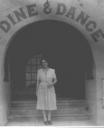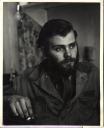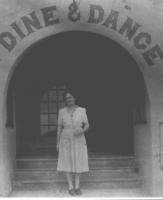 (Photo: Maymie, the madam, poses in front of her longtime domain)
(Photo: Maymie, the madam, poses in front of her longtime domain)  (Photo: Michael McCracken, the “beat leader” who lived at the Abalone Factory in Princeton).
(Photo: Michael McCracken, the “beat leader” who lived at the Abalone Factory in Princeton).
In the late 1970s I first heard of the beatniks who lived in the Abalone Factory out at Princeton….the whole idea of that wild, crazy scene, and Michael McCracken, “the beat leader” caught my fancy just as much as Maymie Cowley had– the red-haired madam who operated out of the Miramar Beach Inn from the heady days of Prohibition to the more sedate 1950s.
I followed up on both McCracken and Maymie Cowley who did not know each other. How I hoped either or both were alive so they could regale me with never-before-heard tales of the Coastside I had grown to love so much. Not just love but I found the Coastside to be a mysterious place, with wonderful and terrible secrets hidden everywhere.
How I wanted to know what I didn’t know but I just knew was there………
With Maymie, the madam, I had nutured a deep hope that she was alive and living in Redwood City. Alas, when I knocked the door of her last known residence, I found out the trail was ice cold. I was a decade too late. Through mortuary documents, I tracked down some relatives in the Mid-West…they wrote back with a little history and a couple of photographs. It was the first time I’d seen what she looked like and, yes, I was a bit disappointed, having believed that if she were a madam, she would look more flamboyant. But in the photos she looked like somebody’s grandma.
Other trivia trickled in over time but none of the really good stuff I was looking for. I don’t mean the madam stuff but she was involved in Prohibition traffic…from her windows,she could see the rumrunners doing their business.
McCracken was something else. Much younger than Maymie, he really could be alive and I thought there was a good chance he was. What would he be like, I wondered. Where was he?
Nobody knew anything–dead ends everywhere– but McCracken was a beatnik and I knew that beatnik life had been preserved in North Beach at San Francisco’s famous City Lights Bookstore. I wrote the poet and owner Lawrence Ferlinghetti and I received a response in the form of a contact name and post office box address in the City.
Turned out that the contact was artist Michael Bowen–who had lived with McCracken at the Abalone Factory. Still, I knew nothing of the whereabouts of McCracken. Maybe when I met up with Bowen at his home in Bolinas he would tell me.
Once again I was too late….Michael McCracken had died young, in his mid-20’s, in London, England.
But if you’ve followed this story, you know that a baby was born in 1963 in the Abalone Factory, the son of Michael McCracken and his wife Carole. Because of my postings that baby, now a very grown-up man [Michael Rothenberg] contacted me–because he, too, has been on a parallel search for the threads of his past– which he learned about less than 10 years ago.


